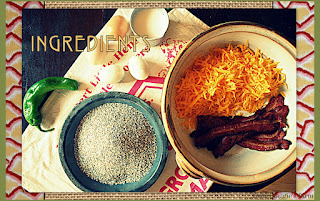As summer winds down, we're all looking for any opportunity to steal away to the porch, or the patio, or the poolside (if you're lucky) for an early supper al fresco.
A great way to keep ourselves, and the heat, out of the kitchen, firing up the grill is this girl's late summer modus operandi. This Meatless Monday, celebrate late summer by piling on the garden or market bounty atop a toasted crust, top it with a summery-seasoned chevre, and enjoy this easy Grilled Summer Vegetable Pizza.
Want to know my favorite thing about this pizza? Vegan, Vegetarian, Meatless, Low Fat, Gluten-Free...it doesn't matter. I don't give those details one thought when I'm digging in. It's not almost as good as its less-healthy cousins. It's just gooood.
Ingredients
prepared pizza crust
roasted red pepper sauce (recipe below)
prepared vegetables (This summer harvest includes red and yellow onions, red, green and golden sweet peppers, crimini mushrooms, yellow, orange, and red pear tomatoes, and fresh sage leaves.)
herbed chevre (see note, below)
Scrape grill to clean and brush with oil. Preheat to around 500 degrees.
This particular pizza was built upon a Udi's brand gluten-free pizza crust. You can use your own homemade crust, or any other pre-made crust you prefer. Brush one side with olive oil. Place it, oil side up, on the grill and close the top. Cook for 5 minutes, turn, brush opposite with light film of oil, close the grill and cook for 5 minutes longer. Why are we cooking it before topping it? It seals the crust and keeps it from getting all soggy and yuck when the toppings begin cooking and releasing their juices.
Remove crust from grill and spread roasted pepper sauce, below, around top of crust. Top with fresh, seasonal vegetables of your choice. We've used red and yellow onions, red, green and golden sweet peppers, crimini mushrooms, yellow, orange, and red pear tomatoes, and fresh sage leaves. This pizza was topped with housemade from maggie's farm Lemon Herbed Chevre. You may use any soft, creamy goat cheese you prefer.
Note: You say you don't have time to make your own chevre? On a Monday? The day school starts? Okay. I get that. Tell you what-- let's pull together an easy substitute. Using a store-bought plain soft and creamy chevre, combine about 2-4 ounces cheese in a mixing bowl with the zest of one lemon, and minced fresh herbs of your choice: parsley, chives, basil, oregano, rosemary, sage, or any combination thereof. Stir to combine, allow to come to room temperature, and then dot the top of the pizza with delectable dollops. I'm not encouraging dishonesty or anything, but, hey, you combined all of this in a bowl didn't you? Why not call it your own housemade chevre? None will be the wiser. (wink, wink.)
Note: For a vegan version, leave the chevre in the case, prepare roasted red pepper sauce employing vegan substitutions, or use a vegan pesto (most pestos are, indeed, vegan, but read your labels for certainty), then proceed with grilling as below.
Transfer pizza to grill. Notice all that stuff on the pizza peel? It's cornmeal, and it will make that pizza glide off with ease. Some of it will stick to the bottom of the pizza...and that's good. It adds a tiny bit of crunch to the bottom crust.
Close the grill top and let pizza roast until the cheese is lusciously melted, and vegetables are browned to your likeness. The more they cook, the softer they'll become. I like mine a little crispy, with the edges browned, cooked a total of about 15 minutes.
Grill peppers like the Hatch chiles we roasted in this recent post. Peel, (perhaps leaving some skin on for a smokier flavor) to yield approximately two cups of cored, seeded pepper halves. Transfer to a food processor bowl, add 2 tablespoons best-quality olive oil, 1T herbed chevre (or substitute silken tofu for vegan version), season with kosher salt and freshly ground pepper, to taste. Process in quick pulses until thick consistency is achieved.
Note: After processing, you may find that peppers have released more juice than you expected-- Mother Nature is not exact-- and it may be too thin to spread consistently. To remedy this, I often add a little parsley, Parmesan cheese, or even nutritional yeast ifA unique base for pizza, this roasted pepper sauce is quite versatile, too. Toss with warm pasta, dress up a simple chicken breast, dip toasted baguette slices in a bowlful. Use to perk a plain-jane dish, and keep a jar refrigerated (for up to a week), to dress up dinner when you are all out of creative food thoughts.I'm teasing myself thatI'm vegan thatday,week, occasion, to acquire the thicker paste we're going for here. You can even use walnuts or almonds, too. Kind of like a pesto with no oil, and no basil. Okay, not much like a pesto, but the consistency of pesto.
Yeah, it happens sometimes, doesn't it? Even to me.
---------------------------------------------
Join Notes From Maggie's Farm tomorrow, on Tips for Tuesday, when we'll extend the grilling season using the freshest of flavors to complement both meats and vegetables-- the Argentine specialty, Chimichurri.
















































